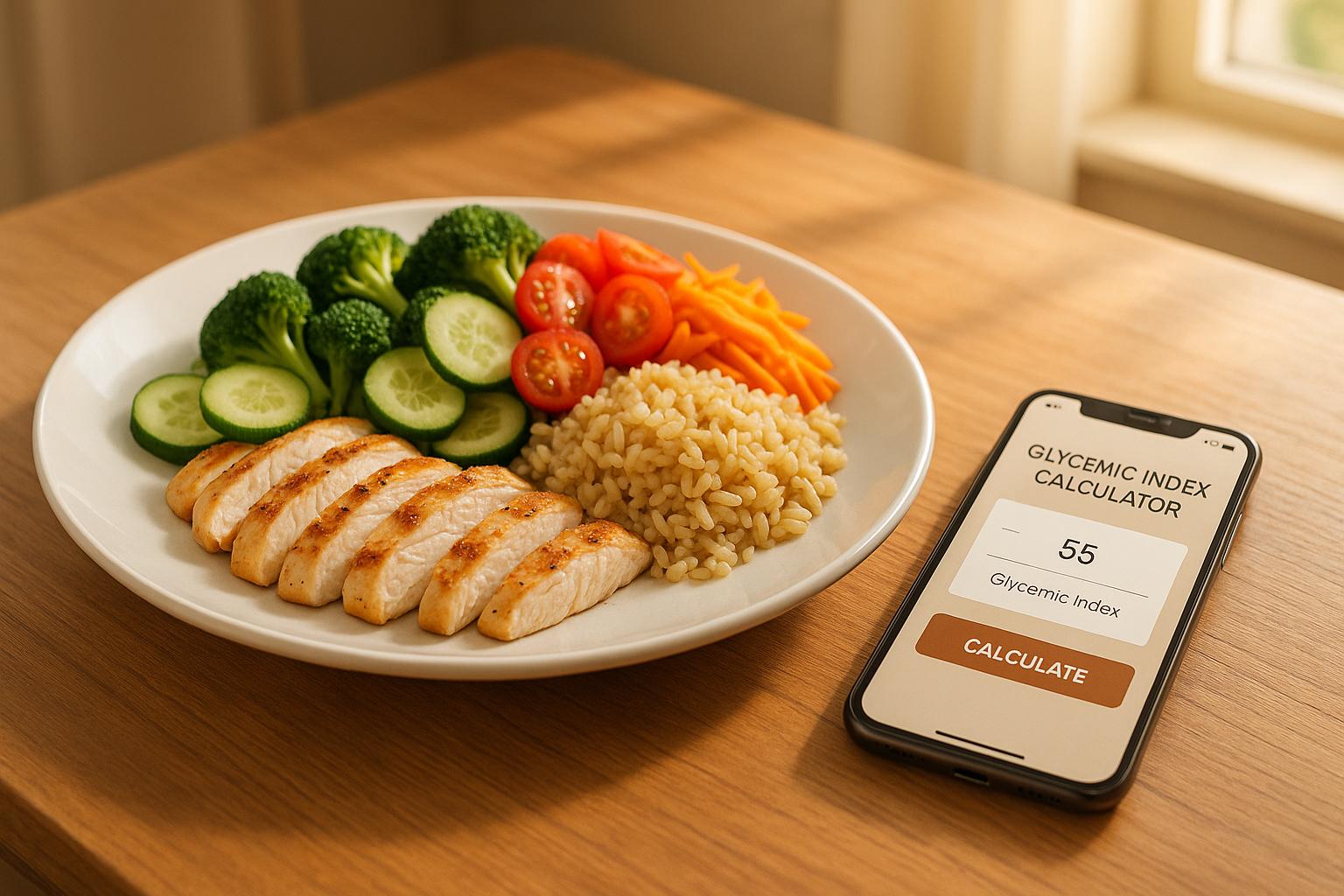Monitoring your blood sugar is key to managing diabetes effectively. How often you test depends on factors like your type of diabetes, treatment plan, and lifestyle. Here's what you need to know:
- Type 1 Diabetes: Test at least 4 times daily (before meals, fasting, bedtime). Additional checks may be needed after meals, during exercise, or when unwell.
- Type 2 Diabetes (with insulin or certain medications): Regular testing (4+ times daily) is recommended to avoid low blood sugar.
- Type 2 Diabetes (without insulin): Daily testing may not be necessary but can help track how food and activity affect levels.
- Prediabetes: Testing is less frequent - usually once every 1-2 years, or annually if recommended by your doctor.
Factors like stress, illness, exercise, or changes in diet can affect blood sugar, so testing frequency might need adjustments. Use tools like blood glucose meters or continuous glucose monitors (CGMs) for accurate readings. Always consult your healthcare provider to determine the best testing schedule for you.
How Often Should I Test My Blood Sugar? Does Age Affect the Frequency of Tests?
What Affects How Often You Should Test Blood Sugar
How often you need to test your blood sugar depends on several factors. It’s not a one-size-fits-all situation, and your individual needs play a big role in determining the right testing frequency.
Type of Diabetes and Treatment Plan
The type of diabetes you have and how you manage it are key factors. For instance, type 1 diabetes, which requires daily insulin use, often calls for frequent testing. This helps you adjust your insulin doses, diet, and exercise effectively to keep your blood sugar in check.
If you have type 2 diabetes, the frequency depends on your treatment. If you’re using medications like insulin, sulfonylureas, or meglitinides, regular testing is important to avoid low blood sugar (hypoglycemia). On the other hand, if you’re managing type 2 diabetes through diet and exercise alone, daily testing may not be necessary. However, structured self-monitoring can still be helpful to understand how your meals and physical activity affect your levels.
Your lifestyle and any changes in your health also influence how often you should test.
Lifestyle and Health Changes
Daily life can impact your blood sugar levels in surprising ways. For example, stress triggers the release of hormones like cortisol and adrenaline, which can raise blood sugar levels. If you’re going through a stressful period, testing more frequently can help you monitor how your body is responding.
Exercise is another major factor. Physical activity often lowers blood sugar for up to 24 hours or more after a workout. Aerobic exercises typically reduce blood sugar levels, but activities like high-intensity training or weightlifting might cause a short-term spike instead. Testing your blood sugar before and after exercise can give you a clearer picture of how your body reacts, allowing you to adjust your routine as needed.
Other factors like illness, changes in diet, or disrupted sleep patterns can also shift your usual blood sugar trends. For example, chronic stress, especially in women, has been linked to an increased risk of developing type 2 diabetes. During times of change, temporarily increasing your testing frequency can help you stay on top of your management plan.
Doctor's Recommendations
Your healthcare provider’s advice is crucial. Testing frequency often depends on factors like your age, overall health, and risk of hypoglycemia. Regular testing not only helps you stay within your target range but also gives your doctor the information they need to fine-tune your treatment and reduce the risk of complications.
As your health, treatment plan, or lifestyle evolves, your testing routine may need adjustments. Always check with your doctor before making changes to how often you monitor your blood sugar.
How Often to Test Based on Your Condition
Your specific health condition plays a major role in determining how often you should check your blood sugar levels. Testing needs can vary widely depending on the type of diabetes, your treatment plan, and your daily habits.
Type 1 Diabetes
If you have type 1 diabetes, regular blood sugar monitoring is a must. Testing at least four times daily - before meals, during fasting, and at bedtime - is generally recommended. Additional checks may be necessary after meals, during exercise, or if you feel symptoms of low blood sugar. You should also test more often when you're feeling unwell, under stress, or if there are changes to your eating schedule or medications.
Type 2 Diabetes: With Insulin vs. Without Insulin
For type 2 diabetes, how often you test depends on whether you're using insulin or medications that can cause low blood sugar.
- With insulin or hypoglycemia-inducing medications: Testing at least four times a day is advised, following similar guidelines to type 1 diabetes.
- Without insulin: If you're managing type 2 diabetes through diet, exercise, or medications that don't cause hypoglycemia, daily testing might not be necessary. A study even found that routine daily self-testing didn't provide extra benefits for those not using insulin. That said, organized self-monitoring can still help you understand how food and activity affect your blood sugar levels. It's a good idea to keep a glucose meter handy for situations like illness, starting new medications, or other changes. Always consult your healthcare provider before adjusting your testing routine.
Prediabetes and Regular Health Checks
For those with prediabetes, testing is much less frequent. Blood sugar levels should be evaluated every 1–2 years. The American Diabetes Association (ADA), the US Preventive Services Task Force (USPSTF), and the Endocrine Society recommend annual testing for individuals with prediabetes. This is particularly important since over 85% of people in the US with prediabetes are unaware of their condition.
Tailoring your testing schedule to your condition and working closely with your healthcare provider ensures effective blood sugar management.
sbb-itb-0899721
Tools and Technology for Blood Sugar Testing
The right tools make all the difference when it comes to monitoring your blood sugar effectively. From traditional glucose meters to continuous glucose monitors (CGMs) and smartphone apps, modern technology offers a range of options to suit different needs.
Blood Glucose Meters and Continuous Glucose Monitors (CGMs)
Blood glucose meters provide a quick snapshot of your blood sugar by analyzing a single blood sample. These devices are highly reliable, with 95% of readings falling within 15% of lab results.
On the other hand, CGMs offer a more dynamic approach. They continuously measure glucose levels in the interstitial fluid, although they may lag behind actual blood sugar levels by 5–15 minutes during rapid changes. Devices like the Dexcom G7 (MARD: 8.2%) and FreeStyle Libre 3 (MARD: 7.9%) are among the most accurate CGMs available. Beyond tracking, CGMs can alert users to dangerously high or low glucose levels, potentially preventing severe complications like hypoglycemia and hyperglycemia. Many CGMs also integrate with insulin pumps, automatically adjusting insulin delivery based on real-time data. Diabetes specialists often recommend combining CGMs with traditional glucose meters for a comprehensive monitoring strategy.
Here’s a quick comparison of the two technologies:
| Feature | Blood Glucose Meters (BGMs) | Continuous Glucose Monitors (CGMs) |
|---|---|---|
| Measurement | Single reading at a time | Continuous glucose tracking |
| Method | Finger prick with test strip | Sensor placed under the skin |
| Data | One-time result | Trends and alerts for highs and lows |
| Convenience | Manual testing required | Automatic and ongoing monitoring |
| Accuracy | High accuracy at the moment of testing | Slight lag during rapid glucose changes |
| Cost | Lower upfront cost | Higher initial and ongoing expenses |
The cost of CGMs can vary significantly depending on the sensor type and insurance coverage.
Apps for Tracking Blood Sugar Data
Smartphone apps are becoming an essential part of blood sugar management. For example, the Logi – Glycemic Index Tracker App offers a range of features to help users make informed dietary choices. This app scans meals for their glycemic load, tracks daily food intake, and suggests lower glycemic alternatives. Key features include:
- A meal glycemic load scanner to analyze food choices.
- A daily meal tracker to monitor eating habits.
- Insights into how specific foods impact blood sugar levels.
- A low GI/GL food alternatives finder to recommend healthier options.
Logi offers a free basic plan, with premium features available for $9.99/month and a professional tier for $19.99/month. These tools make it easier to stay on top of your blood sugar management while offering actionable insights for better control.
CGMs also enhance connectivity by allowing healthcare providers to remotely view your glucose data. This enables doctors to make adjustments to your treatment plan in real time, without waiting for your next visit.
Alternative Testing Sites
For those who find fingertip testing uncomfortable, alternative sites like the palms or forearms can provide relief. However, it’s essential to follow proper testing procedures, as factors like improper storage of test strips, extreme temperatures, or residue on the skin can impact accuracy. Avoid using secondhand test strips, as these can lead to unreliable results.
While fingertip testing remains the most accurate method, the ADA 2025 Standard of Care endorses CGMs for individuals with Type 2 diabetes - even for those not on insulin. Unfortunately, access to CGMs isn’t equitable, with barriers often affecting poorer, older, Black and Brown Americans, and Medicaid recipients.
Next, we’ll look into how alternative testing methods can make blood sugar monitoring more comfortable and convenient.
Creating Your Personal Testing Schedule
Now that you have the tools you need, it’s time to design a blood sugar testing schedule that works for your health needs and daily routine. Blood glucose targets can vary depending on factors like how long you’ve had diabetes, your age, other health conditions, cardiovascular risks, and even hypoglycemia unawareness. Use what you’ve learned about testing frequency and the technology available to create a plan that fits your life.
Work closely with your healthcare provider to fine-tune your schedule. They can guide you on when and how to monitor your blood sugar levels and help interpret your results. Your care team can also demonstrate the proper use of blood sugar meters and determine the best testing frequency and timing for your treatment plan.
Keep a detailed record of your readings along with notes on your meals, physical activity, stress levels, and medication timing. These details can be incredibly helpful during medical visits, as reviewing trends may help your doctor adjust your care plan for better results.
Technology can simplify and improve your monitoring process. For example, the Logi – Glycemic Index Tracker App works alongside traditional blood sugar testing by helping you see how different foods impact your glucose levels. Its meal glycemic load scanner lets you evaluate your food choices before they affect your blood sugar, while the daily meal tracker highlights patterns in your diet that might influence your readings. With features like low GI/GL food alternatives and tailored insights, Logi helps you connect testing with smarter management. Use these insights to make adjustments to your testing routine.
Be ready to adapt your schedule when life throws you a curveball. Changes in food, medication, or activity levels can cause blood sugar fluctuations, and situations like illness or travel may require temporary adjustments. If you’re already monitoring your blood sugar, don’t make any changes to your routine without consulting your doctor first.
FAQs
How do changes in stress or exercise affect how often I should test my blood sugar?
Stress and physical activity can both play a role in how often you might need to check your blood sugar levels. Let’s break it down:
Stress - whether emotional or physical - can trigger hormones like cortisol and adrenaline. These hormones often cause blood sugar levels to rise. If you’re dealing with high levels of stress, it’s a good idea to test more frequently to keep an eye on any changes.
On the flip side, exercise tends to improve insulin sensitivity and help regulate blood sugar. That said, the intensity and timing of your workouts can lead to temporary spikes or drops in blood sugar. Testing both before and after exercising can give you a better understanding of how your body responds, helping you make adjustments as needed.
Keeping these factors in mind allows you to fine-tune your testing routine for better blood sugar management. If you’re looking for extra support, tools like the Logi - Glycemic Index Tracker App can help you track trends and make smarter health decisions.
What are the benefits of using a Continuous Glucose Monitor (CGM) compared to a traditional blood glucose meter?
A Continuous Glucose Monitor (CGM) offers some standout advantages compared to traditional blood glucose meters. While fingerstick tests provide a single snapshot of your glucose level at a specific moment, CGMs deliver real-time, continuous glucose tracking around the clock. This constant flow of data makes it easier to identify patterns and trends, empowering you to make smarter choices for managing your blood sugar.
Another big plus? CGMs cut down on the need for frequent fingerstick tests, making them a more convenient and less intrusive option. They can also send alerts for dangerous blood sugar highs or lows - even while you’re asleep - so you can make timely adjustments and avoid potential complications. For those using insulin to manage diabetes, CGMs have been shown to improve blood sugar control and help lower HbA1c levels over time.
To further support your blood sugar management, the Logi - Glycemic Index Tracker App pairs well with CGM data. Logi allows you to log meals, scan foods for their glycemic load, and find low-GI alternatives, giving you a broader toolkit to maintain steady energy and overall better health.
How should I change my blood sugar testing routine during illness or major lifestyle changes?
When you're unwell or experiencing major lifestyle changes, it's crucial to check your blood sugar more often - about every 4 to 6 hours. Illness, stress, or shifts in your routine can lead to unexpected swings in blood sugar levels, and staying on top of it can help you avoid complications.
Stick to your prescribed medications and usual diet as much as possible. If adjustments, like tweaking your insulin doses, become necessary, make sure to consult your healthcare provider. Frequent monitoring during these periods plays a big role in keeping your blood sugar stable and preventing serious problems.



